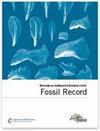下载PDF
{"title":"内华达红山1号晚中泥盆世动物群及其古生物地理意义","authors":"Hans-Peter Schultze","doi":"10.1002/mmng.201000001","DOIUrl":null,"url":null,"abstract":"<p>The fauna of the Middle Devonian Red Hill I locality, Nevada, is unusual in the co-occurrence of a rich fish assemblage with a rich invertebrate one. Sponges are second in abundance of specimens and number of species only to the fishes and occur together with other invertebrates (conodonts, conulariids, dacryoconarid tentaculites, gastropods, bivalves, brachiopods, arthropods, and unidentifiable ammonoids and echinoderms). The invertebrates indicate a marine depositional paleoenvironment. The conodonts indicate a placement within the lower <i>disparalis</i> Zone, late Givetian. The fish assemblage is dominated by the antiarch <i>Asterolepis</i>. All the other fishes, acanthodians, actinopterygians and sarcopterygians, are less common. The closest biogeographic relationship of the fish fauna is with the Middle/Late Devonian fish fauna of the Baltic Region, followed by that of eastern Canada (Miguasha), Scotland and Iran. This distribution corresponds to the Devonian Euramerica faunal province with connection to eastern Gondwana (Iran and Australia). Localities with the same genera as Red Hill I are interpreted as marine with the exception of the Scottish localities. <i>Asterolepis</i> is the most widely distributed vertebrate genus, mostly marine, but it may be able to enter freshwater like <i>Eusthenopteron</i> if one accepts a freshwater depositional paleoenvironment for the Scottish localities. (© 2010 WILEY-VCH Verlag GmbH & Co. KGaA, Weinheim)</p>","PeriodicalId":55147,"journal":{"name":"Fossil Record","volume":null,"pages":null},"PeriodicalIF":1.4000,"publicationDate":"2010-08-05","publicationTypes":"Journal Article","fieldsOfStudy":null,"isOpenAccess":false,"openAccessPdf":"https://sci-hub-pdf.com/10.1002/mmng.201000001","citationCount":"7","resultStr":"{\"title\":\"The late Middle Devonian fauna of Red Hill I, Nevada, and its paleobiogeographic implications\",\"authors\":\"Hans-Peter Schultze\",\"doi\":\"10.1002/mmng.201000001\",\"DOIUrl\":null,\"url\":null,\"abstract\":\"<p>The fauna of the Middle Devonian Red Hill I locality, Nevada, is unusual in the co-occurrence of a rich fish assemblage with a rich invertebrate one. Sponges are second in abundance of specimens and number of species only to the fishes and occur together with other invertebrates (conodonts, conulariids, dacryoconarid tentaculites, gastropods, bivalves, brachiopods, arthropods, and unidentifiable ammonoids and echinoderms). The invertebrates indicate a marine depositional paleoenvironment. The conodonts indicate a placement within the lower <i>disparalis</i> Zone, late Givetian. The fish assemblage is dominated by the antiarch <i>Asterolepis</i>. All the other fishes, acanthodians, actinopterygians and sarcopterygians, are less common. The closest biogeographic relationship of the fish fauna is with the Middle/Late Devonian fish fauna of the Baltic Region, followed by that of eastern Canada (Miguasha), Scotland and Iran. This distribution corresponds to the Devonian Euramerica faunal province with connection to eastern Gondwana (Iran and Australia). Localities with the same genera as Red Hill I are interpreted as marine with the exception of the Scottish localities. <i>Asterolepis</i> is the most widely distributed vertebrate genus, mostly marine, but it may be able to enter freshwater like <i>Eusthenopteron</i> if one accepts a freshwater depositional paleoenvironment for the Scottish localities. (© 2010 WILEY-VCH Verlag GmbH & Co. KGaA, Weinheim)</p>\",\"PeriodicalId\":55147,\"journal\":{\"name\":\"Fossil Record\",\"volume\":null,\"pages\":null},\"PeriodicalIF\":1.4000,\"publicationDate\":\"2010-08-05\",\"publicationTypes\":\"Journal Article\",\"fieldsOfStudy\":null,\"isOpenAccess\":false,\"openAccessPdf\":\"https://sci-hub-pdf.com/10.1002/mmng.201000001\",\"citationCount\":\"7\",\"resultStr\":null,\"platform\":\"Semanticscholar\",\"paperid\":null,\"PeriodicalName\":\"Fossil Record\",\"FirstCategoryId\":\"89\",\"ListUrlMain\":\"https://onlinelibrary.wiley.com/doi/10.1002/mmng.201000001\",\"RegionNum\":4,\"RegionCategory\":\"地球科学\",\"ArticlePicture\":[],\"TitleCN\":null,\"AbstractTextCN\":null,\"PMCID\":null,\"EPubDate\":\"\",\"PubModel\":\"\",\"JCR\":\"Q3\",\"JCRName\":\"Earth and Planetary Sciences\",\"Score\":null,\"Total\":0}","platform":"Semanticscholar","paperid":null,"PeriodicalName":"Fossil Record","FirstCategoryId":"89","ListUrlMain":"https://onlinelibrary.wiley.com/doi/10.1002/mmng.201000001","RegionNum":4,"RegionCategory":"地球科学","ArticlePicture":[],"TitleCN":null,"AbstractTextCN":null,"PMCID":null,"EPubDate":"","PubModel":"","JCR":"Q3","JCRName":"Earth and Planetary Sciences","Score":null,"Total":0}
引用次数: 7
引用
批量引用


